Casentino - Crafts and Industrial Traditions
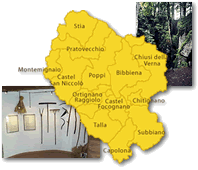
A valley that abounds in historical, artistic and religious attractions, in recent years the Casentino has witnessed a process of revaluation of its historical-scientific-cultural heritage, enacted through the realisation of numerous initiatives aimed at recovering the territory’s crafts and industrial traditions. Part of these projects involves the lower Casentino, following an itinerary which, from the capital city of the province, unfolds for some 70 km.
Leaving Arezzo on the Via Casentinese, take SR71 northwards in the direction of Bibbiena until some 15 km ahead you reach the locality of Castelnuovo di Subbiano, location of the local Museo della Casa Contadina which belongs to the Casentino Ecomuseum of Farming-Shepherding.
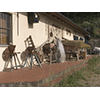
The Museo della Casa Contadina was opened to the public in 1998 and is managed by the Janus Museum Cultural Association, instituted in the same year. In 1999 it became part of the Casentino Ecological Museum's Agricultural and Pasturage System. In the building it occupies, which replicates the typical rural house of the Lower Casentino area, the working environments and domestic life of the peasants have been reconstructed. The exhibition is organized in a sequence based on the activities carried out in the various spheres. From the cellar to the stables to the kitchen, each room conserves the ancient instruments employed in the work done there.
The ethnological collection, which has been catalogued by the Region of Tuscany, was put together over the course of many years by Giancarlo del Pasqua, President of the Association. The exhibition includes not only the previously mentioned objects of domestic use, but also instruments linked to the activities of farming and craftsmanship (shoemakers and smith's tools) dating from the 19th and 20th centuries.
(Stefania Mangia)
Taking SR71 again and proceeding towards Bibbiena, after a short stretch, you reach the town of Capolona which, at "La Nussa" Power Plant, is home to the Water Educational Centre that can be visited by appointment.
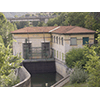
The Museo dell'Acqua, which opened in 2001 and belongs to the Water System of the Casentino Ecomuseum, is housed in the building of the "La Nussa" hydro-electric power station. The still functioning power station was built in the early 20th century on the site occupied, since the 18th century, by a mill. Destroyed by the Germans, it was rebuilt in 1946. The Museum is the point of departure for a thematic itinerary on water in the Casentino territory. Its purpose is to illustrate the various ways of using water, from fundamental alimentary resource to decisive element for the production of energy, indispensable to drive the machines of mills, fullers and ironworks.
The first section of the Museum is dedicated to the "waters of the valley", that is to the hydraulic network created around the River Arno and its tributaries. The second section describes the bridges that connect the various towns that have risen along the course of the Arno, and the structures of the river ports, such as those of Badia di Pratovecchio and Ponte a Poppi. The following sections explain the importance of water for the manufacturing and industrial activities of the Casentino valley; in particular, the "artificial machines" section illustrates the uses of water as motive power, and the various machines used in hydraulic mills. Finally, there is a section dedicated to the therapeutic aspect of water and the various springs with particular curative properties, such as the sulphuric-chalybeate waters of Chitignano or those of the ancient Cetica Baths.
The Museum also houses a laboratory where experiments can be conducted on the physical-chemical properties of water and on hydrodynamic principles. In particular, two sections are dedicated to education: the one entitled "Trickling Water: little experiments for great principles", makes it possible to illustrate, with simple instruments, the principles of capillarity, of communicating vessels, of the reaction turbine; the other one entitled "Wise Drops", presents a fascinating exhibition with the answers to curiosities about water that "rains from the roof".
(Graziano Magrini)
On completing this visit that illustrates the region’s hydraulic resources and the principal activities tied to them, take regional road 71 for a few kilometres, turn onto SP59 for Talla and, in the locality of Salutio, you can visit two tokens of the Casentino manufacturing activity. The first, the Bonano Mill, is an eighteenth-century structure.
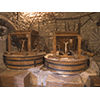
Built in the late 18th century, the Bonano Mill was restructured in 1999, reviving its old structures. It is sited on the homonymous stream which, by means of deviations, supplies the water needed to drive the paddle that makes the grindstone turn. Today private property, it is still used to grind chestnuts and maize. A short distance upstream, it is possible to visit the Bonano Ironworks, another significant example of the old and productive manufacturing activity of the Casentino.
(Graziano Magrini)
A short distance uphill, the Bonano Ironworks is a hydraulic-powered iron factory.
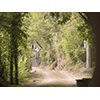
This hydraulic manufactory utilised the water of the Bonano stream for working iron. Proposed in the ambit of the Casentino manufacturing system, of which it is one of many examples, it conserves the machinery and hydraulic organisation necessary to produce motive power. The old Bonano Mill can be admired a short distance downhill.
(Graziano Magrini)
The itinerary continues about 7 km on SP61 towards the picturesque village of Castel Focognano that is the site of an ancient, recently restructured lookout tower that houses the Centro di Documentazione della Cultura Rurale del Casentino.
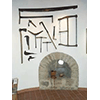
Founded in 1996, the Centro di Documentazione della Cultura Rurale del Casentino (CDCR) forms part of the Agricultural-Pasturage System of the Casentino Ecological Museum. It is located in the little Watchtower of the ancient Borgo di Castel Focognano, the only remains of the eleventh-century castle, destroyed by Bishop Tarlati in 1322.
The Centre has collected material evidence of the activities of the Casentine population along with consistent documentation on the local traditions, beliefs, habits and customs. The collection is made up of various sections linked to specific to the agricultural-forestry-pasturage culture of the Casentino territory: work in the woods and on the land, pasturage, and wool-processing. The objects are displayed without barriers, allowing visitors to interact with them. Most of the tools were collected, in the two years prior to the opening of the museum, from private individuals in the area, and were then restored.
(Stefania Mangia)
Time permitting, we advise a detour of about 35 km on SP208 to see the La Verna Sanctuary, a monastery of medieval origin, tied to the figure of Saint Francis of Assisi. Sited in a woodland of great significance from the botanical viewpoint, the complex presents innumerable art sites, as well as interesting testimonies of a scientific nature.
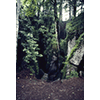
After a long period of closure due to a number of thefts, on December 7, 2002 the new La Verna Museum was inaugurated. It bears witness to the art, history and monastic life in the Sanctuary, in an itinerary that unfolds through a number of rooms up terminating in that of the "common hearth", in which the community met each evening.
The museum's itinerary includes the Ancient Pharmacy, instituted in 1549 at the expense of Cosimo de' Medici and his wife Eleonora di Toledo, now restored in a room situated inside the Sanctuary. Already in the 17th century the products of the pharmacy were famous, so much so that the monastery's pharmacists spent a period of training there before going on the pharmacy in Florence, situated in the monastery of Ognissanti. After a slow decline, the pharmacy was closed 1866 subsequent to the law sanctioning closure of the monasteries.
Today the furnishings and pharmaceutical equipment that document its ancient history include: walnut shelves with doors and vitrines, slender columns and decorations in the style of the first half of the 19th century, majolica jars bearing the monastery's coat of arms with a cross supported by three mountains, albarellos and alembics for distilling made of antique pharmaceutical glass. On the same floor as the pharmacy, in the cloistered area, is a rare example of a column clock from the 18th century, actuated by weights, signed Francesco Nuzzi di Rincine. Restored a few years ago by the Arezzo clockmaker Francesco Burzi, it is still functioning.
The Museum possesses a number of scientific instruments, including two antique quadrants, three hourglasses and a perpetual calendar. It also has two herbariums: the Herbarium Semplici in natura [Medicinal herbs in nature] collected by Francesco Maria Venturini in 1711 and the Herbier by A. Philouse from 1950.
(Mara Miniati)
****************************
Texts by Elena Fani
English translation by Victor Beard
Last update 24/gen/2008



 = libraries and archives
= libraries and archives  = scientific research centers
= scientific research centers  = memorial places of scientists
= memorial places of scientists = public health places
= public health places = places of science and worship
= places of science and worship = places of technology
= places of technology  = museums and collections
= museums and collections  = villas and gardens of science
= villas and gardens of science

